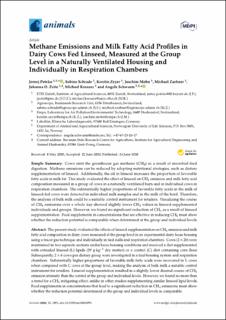| dc.contributor.author | Poteko, Jernej | |
| dc.contributor.author | Schrade, Sabine | |
| dc.contributor.author | Zeyer, Kerstin | |
| dc.contributor.author | Mohn, Joachim | |
| dc.contributor.author | Zaehner, Michael | |
| dc.contributor.author | Zeitz, Johanna O. | |
| dc.contributor.author | Kreuzer, Michael | |
| dc.contributor.author | Schwarm, Angela Dagmar | |
| dc.date.accessioned | 2020-11-11T09:42:04Z | |
| dc.date.available | 2020-11-11T09:42:04Z | |
| dc.date.created | 2020-06-26T08:50:31Z | |
| dc.date.issued | 2020 | |
| dc.identifier.citation | Animals 2020, 10(6), 1091 | en_US |
| dc.identifier.issn | 2076-2615 | |
| dc.identifier.uri | https://hdl.handle.net/11250/2687293 | |
| dc.description.abstract | Cows emit the greenhouse gas methane (CH4) as a result of microbial feed digestion. Methane emissions can be reduced by adopting nutritional strategies, such as dietary supplementation of linseed. Additionally, the oil in linseed increases the proportion of favorable fatty acids in milk fat. This study evaluated the effect of linseed on CH4 emission and milk fatty acid composition measured in a group of cows in a naturally ventilated barn and in individual cows in respiration chambers. The substantially higher proportions of favorable fatty acids in the milk of linseed-fed cows were detected in individual milk samples and in the milk of the herd. Therefore, the analysis of bulk milk could be a suitable control instrument for retailers. Visualizing the course of CH4 emissions over a whole day showed slightly lower CH4 values in linseed-supplemented individuals and groups. However, we found no significant reduction of CH4 as a result of linseed supplementation. Feed supplements in concentrations that are effective in reducing CH4 must show whether the reduction potential is comparable when determined at the group and individual levels. | en_US |
| dc.language.iso | eng | en_US |
| dc.rights | Attribution-NonCommercial-NoDerivatives 4.0 Internasjonal | * |
| dc.rights.uri | http://creativecommons.org/licenses/by-nc-nd/4.0/deed.no | * |
| dc.title | Methane emissions and milk fatty acid profiles in dairy cows fed linseed, measured at the group level in a naturally ventilated housing and individually in respiration chambers | en_US |
| dc.type | Peer reviewed | en_US |
| dc.type | Journal article | en_US |
| dc.description.version | publishedVersion | en_US |
| dc.source.pagenumber | 18 | en_US |
| dc.source.volume | 10 | en_US |
| dc.source.journal | Animals | en_US |
| dc.source.issue | 6 | en_US |
| dc.identifier.doi | 10.3390/ani10061091 | |
| dc.identifier.cristin | 1817212 | |
| dc.relation.project | Andre: Swiss Federal Office for the Environment | en_US |
| dc.relation.project | Andre: Swiss National Science Foundation 406940-145144 | en_US |
| cristin.ispublished | true | |
| cristin.fulltext | original | |
| cristin.qualitycode | 1 | |

